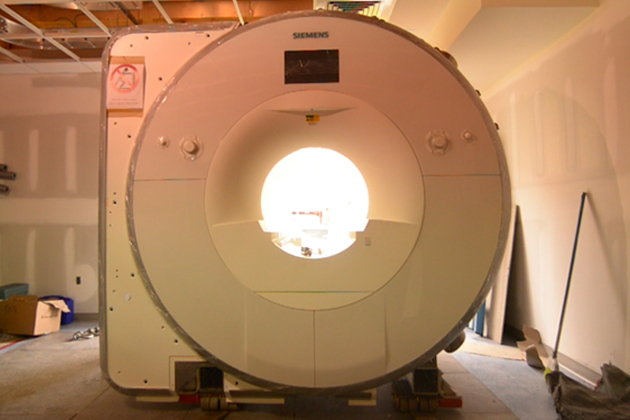https://instagram.com/p/0D6McJy734/
A group of eager scientists and a small gathering of onlookers were on hand Tuesday to watch the careful delivery of a brand-new MRI scanner that promises to give researchers their clearest pictures yet of the inner workings of the human brain.
The scanner will be the centerpiece of the new Brain Imaging Research Center (BIRC) at the University of Connecticut, and marks an important milestone in UConn’s continuing rise to prominence in the cognitive and brain sciences.
The scanner, made by the Siemens engineering company, weighs in at more than 10 tons, and had to be hoisted into its final destination inside the David C. Phillips Communication Sciences Building by crane. The device is the company’s newest and most advanced model, and will offer UConn researchers one of the most advanced imaging platforms available anywhere in the world. Unlike some systems that serve medical patients by day and are only available for research at night, the BIRC scanner will be devoted solely to research.
“This is huge,” said Emily Myers, an assistant professor of speech, language, and hearing whose work makes heavy use of MRI brain scans. “This scanner is really the top-of-the-line instrument for research … It’s a big leap beyond the previously available research scanners.” For Myers, the installation also has more practical considerations: for more than three years she has been traveling to Brown University to use the MRI scanner there, but will now have a more advanced instrument just steps from her office.
Myers said the importance of the BIRC goes beyond the presence of the scanner, which is only one of the brain scanning technologies the center will ultimately possess. “It’s going to bring all of us who are already doing imaging research on campus to the same hub. That’s where the cross-pollination of ideas happens.”
The goal of the center is to provide faculty members currently involved in brain research using MRI with a world-class instrument, as well as to encourage researchers not currently using the technology to explore its potential. Projects currently planned for the center include work on the nature of language, the origin of speech, and recovery from traumatic brain injuries.
“I’m particularly excited by the new lines of research,” said Jay Rueckl, professor of psychology and director the the new center. “Many of them involve new and often interdisciplinary collaborations.” Joining Rueckl is Peter Molfese, director of MRI operations, who came to UConn from Yale University.
The installation of the scanner marks the final phase of construction of the BIRC, which has been in development for more than three years. The instrument will require a thorough breaking-in and calibration before it can be used, but if all goes as planned it will be fully operational by the fall of 2015.



